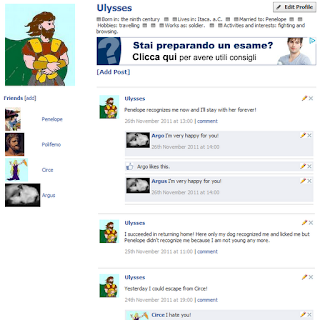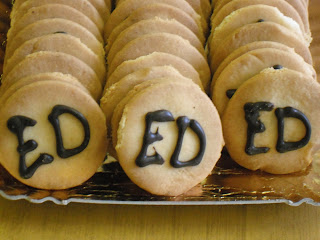Classtools is a fabulous site, with great resources to use with students.
These are the steps my class and I went through when dealing with diary writing.
1) Choosing a fictional, historical, cartoon or legendary character.
2) Creating Fakebook profiles and writing diary entries.
Some of them didn't use the web tool and drew their own profiles on paper.
Here are some samples from students' works.
Click here to view fullscreen.
Click here to view fullscreen
Click here to view fullscreen
3) Editing the writing and getting feedback from the teacher
4) Printing the profiles
5) "Visiting" each other's profiles and commenting on them using post-it notes.
Students, in their character's shoes, could leave a public message on the wall, that everyone could read and comment, or write a private "message" ( a folded post-it ) that only the owner of the profile could open and read.
This activity, which took us 3 class hours , let the students have a lot of practice at asking questions, reading and writing. And I especially liked the fact that both technology and paper proved to be effective tools and worked together to reach the teaching aim.
"You talk as if a god had made the Machine.. Men made it, do not forget that. Great men, but men. The Machine is much, but it is not everything. I see something like you in this plate, but I do not see you. I hear something like you through this telephone, but I do not hear you. That is why I want you to come. Pay me a visit, so that we can meet face to face, and talk about the hopes that are in my mind."The machine stops - 1909 - Forster
Tuesday, January 24, 2012
Monday, January 23, 2012
INTEGRATING TECHNOLOGY: vocabulary expansion
What follows is a way to help students expand their vocabulary.
Especially at elementary level they tend to overuse the same basic words and their essays are quite repetitive.
Last week my class ( third year middle school ) was given a written test : " My trip to England", as a closing activity after a civilization unit about the United Kingdom.
While checking their essays I noticed their writings were full of words such as "go", "beautiful", "place" and "see".
I wanted to make them visually aware of this and so I asked them to recopy their texts using the computer, to save the file, to copy the document and to paste it into Wordle.
These are some of the word clouds they created.
At school, the following lesson, the students examined each other's clouds and commented on them.
So we decided to work on the BIG words, the ones which recurred more often in their writings, and to find synonyms.
On the IWB we used a free visual Thesaurus .
Especially at elementary level they tend to overuse the same basic words and their essays are quite repetitive.
Last week my class ( third year middle school ) was given a written test : " My trip to England", as a closing activity after a civilization unit about the United Kingdom.
While checking their essays I noticed their writings were full of words such as "go", "beautiful", "place" and "see".
I wanted to make them visually aware of this and so I asked them to recopy their texts using the computer, to save the file, to copy the document and to paste it into Wordle.
These are some of the word clouds they created.
At school, the following lesson, the students examined each other's clouds and commented on them.
So we decided to work on the BIG words, the ones which recurred more often in their writings, and to find synonyms.
On the IWB we used a free visual Thesaurus .
We also used a great tool to work with collocations, Just the word.
The students updated their lexical notebooks with all the new nouns, verbs and adjectives.
I told them that, at this point, they had to take their essays and try to make them better,by adding and substituting words in the texts whenever possible.
One of them had a brilliant idea and proposed: " What if we do the same wordle thing again? After the redrafting, in the clouds there shouldn't be any big words. We should end up with a plain text!"
They liked the solution and, the following lesson, they were proud of their new wordle clouds.
Here are two of them.
For more ideas on how to use Wordle in the classroom have a look at this presentation by David Dodgson.
You can also find interesting ideas here.
************************
PS What if I put this post into Wordle?
Whoops! Too many "words clouds" and "students"!
Labels:
ESL ACTIVITIES,
INTEGRATING TECHNOLOGY,
vocabulary,
web2
Thursday, January 19, 2012
How to make students "digest" the Past Simple
PAST SIMPLE : AN EASY RECIPE
Ingredients
- from 20 to 25 students beginner level ( possibly aged 12-13 )
- at least 100 biscuits decorated with chocolate ED
- a blackboard or IWB
45 minutes
Instructions
Tell students you have both GOOD news ans bad news.
Ask them what they want to start with ( for a better result make them choose the first option ).
Elicit verbs in the infinitive. Write just the GOOD ones on bb ( if they say "eat", "sleep", "go"...make a sad face and say "sorry, that is bad news" ). When you have a lot of them displayed on the blackboard, tell them to close their eyes.
Explain they're going to learn how to form the past tense. Point out the fact that it's going to be hard work and
that their brains need a lot of sugar to take in the information.
After some "reflection" time, invite them to open their eyes. Show them the box with the biscuits.
Enjoy the smiling faces.
Make them understand they have to "eat" the Past Simple in order to "digest" it.
Serve the biscuits which can't be eaten until a lot of class drilling has been done.
At this point, in pairs, students eat and speak, repeating the verbs with the correct ending pronunciation and with their mouth full. :)
Next, pass to the bad news ( the irregular verbs with their forms to be studied by heart )
Homework for the following lesson : digest the Past Simple.
*******************************
I thought this could be an example of good practice......
Subscribe to:
Posts (Atom)






























